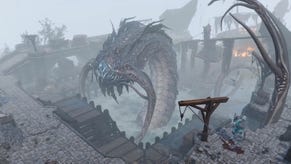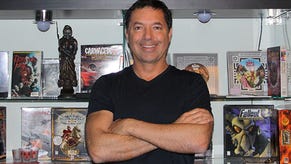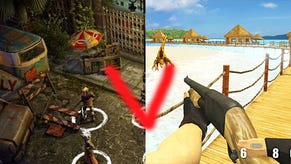A Day With Wasteland 2
Unexiled
I recently had the privilege of visiting inXile's balmy, exceedingly pleasant beachside lair (they don't make exiles like they used to) - at which point I of course did my best to avoid the light of day as much as possible. I was in Southern California for one reason and one reason only: to explore a festering, godforsaken bullet hole of a wasteland, and this time it wasn't even Los Angeles. Or at least, not the real one. Wasteland 2 was the name of the game, and inXile was kind enough to show me, well, pretty much everything.
There is something profoundly wonderful about the fact that inXile - undisputed champion of Kickstarter and mischievous deity of worlds that span all realms of imagination - shares sign space with a Subway. Actually, Subway gets prime strip mall signpost billing, resting comfortably atop inXile's jagged letters like Joffrey lounging in the Iron Throne. When I first strolled into the sun-boiled parking lot, I didn't even notice inXile's spot on the lineup at all. I bet CITI DONUT and Salon Island Nails do great business, though.
The whole scene was just perfect. In retrospect, I have to chuckle.
Not so long ago, inXile was very nearly dead to the outside world. Hunted: Demon's Forge brewed nothing but steaming contempt in the guts of those who played it, and resulting cost cuts forced the once-proud company to shrink from 60 employees to around 15. Huddled in a single, cluttered office where once its oceanfront empire spanned three, it all seemed a bit like, well, the end of the world. And of course, the only remnant of civilization was a proudly posed Subway sandwich shop - a grimy chain held together by America's love affair with both belt size vanity and festering unhealth. It would be.
Times have, of course, changed, but inXile's office is still tiny, cluttered, and cramped. Life imitates art, I suppose, and the heart of Wasteland 2's operation resembled the very sort of starving pit of industry one might stumble across in games like Fallout or the original Wasteland. Just, you know, with more people in it. If there was a surface, it was strewn with cups, papers, hastily scrawled notes, and maps of lands both real and fictional. Walls looked like they were suffocating, and there was a Guitar Hero guitar hanging from the ceiling for some reason. Dim morning light crept in where it could, prowling between papers, PCs, and replica Fallout power armor helmets alike.
inXile head Brian Fargo looked downright giddy. Suddenly, I no longer wondered where the sun was hiding given that I was pretty sure he ate it. But despite everything else, this was the moment of truth, and Fargo knew he and his team were ready.
In The Beginning...
Wasteland 2 begins with the "retirement party" of a Wasteland 1 Ranger named Ace. But it's a joke, you see. The punchline is that Ace is dead. Welcome to the Wasteland.
It's here that you're handed your first Ranger mission: investigate some seriously creepy radio signals that are clogging the airwaves all throughout your parched paradise of a homeland. Here, Fargo and co briefly demonstrate the ever-controversial keyword-based dialogue system. Now, when you mouse over a keyword, you actually get a readout of what your Ranger will say, thus preventing Commander Shepard/Cole Phelps-style rage explosions when you were just wondering where to find the little Scorpitron's room. It still wasn't the most elegant-looking solution ever, but it got the job done. Plus, inXile promised that most of the interface - admittedly rather clunky looking - was still placeholder. A few mock-ups of newer versions looked much cleaner.
And so, we set off. Our first stop: a prison in Arizona that once served as Wasteland 1's Ranger Citadel. Long since abandoned, it instead played host to all sorts of greedy gangs. Naturally, one, the Red Skorpion Militia, wanted to "tax" our intrepid four-person law enforcement party for, er, carrying guns, because... look this is a robbery, alright? Do they really need a good reason? Combat followed shortly thereafter. Without missing a beat, the world went turn-based - just like in the '90s, before seamlessly flowing time was invented. At its most basic, the quick, painfully lopsided skirmish played out like a very simple XCOM battle, except with less cover and even more overpowered sniper rifles. Colored grid regions indicated range (green = very little chance of missing, yellow = mid-range, red = long shot) and it wasn't long before the bandits had a change of heart and politely died. It was, however, extremely basic. Almost worrisomely so.
For combat, however, that is only the very, very, very, very, very, very, very tip of the iceberg. The opening areas mostly consisted of melee enemies and flat lands without even the thinnest slabs of cover to hide their shame, but complexity emerged in fairly short order. I witnessed another, still very unfinished area with plenty of cover and enemies that flanked, sniped, and generally proved quite adept at making dangerously fatal nuisances of themselves. That, said inXile, is actually just the baseline.
"We wanted to make sure that we were able to craft encounters," explained project lead Chris Keenan. "A lot of the RPGs that we were playing, they had a basic AI set on them, and they just did that. Run to player, shoot, generally stand back this far. We want to try to make sure that we’re getting interesting behaviors with these guys as far as flanking opportunities that they can see. Actively using height to their advantage. Working in groups. Sending two guys around one way and one guy around the other way."
"There’s plenty of cover in the game, but it doesn’t feel manufactured," added Fargo. "It feels more natural, like part of the environment. There are areas where there’s no cover and areas where there’s lots of cover. We’ll take that into account as we balance the game. We may give you a lot more enemies in areas where there’s a lot of cover, behind the scenes. Or there’s going to be snipers up on the roof, because we deal with height and distance as well, thanks to a modified Mercenaries, Spies, and Private Eyes rule set - kind of like the original Wasteland. So that might affect where we could make cover available."
"Another part of this, too, is that while you’re in combat there, you can still use your [typically non-combat-related] skills," said Keenan. "If there were locked doors over on this side, you could drop bombs and use demolition skills. You could go unlock an area, which might take you to a little corridor that takes you up a ladder, and now you have a nice position behind another guy who’s up on the roof shooting down at you. He doesn’t notice you behind him."
Of Course There's A Toaster Repair Skill
Skills are everywhere in Wasteland 2. They are its protruding backbone, and you absolutely must choose them wisely. The system heavily ties into the extreme levels of reactivity and choice inXile is in the process of honing, on both micro and macro levels. For example, a traveling salesman needed assistance moving his merchandise out of a ditch. Brute force was the obvious solution, and it got us reduced prices for our troubles. Hurrah! But we also could've possibly talked him down to that price point - no miserable peasant labor involved - or dug deeper into a roster of 32 possible skill types for some other option. The only problem? All I saw were very early, fairly basic skills. inXile told me that things get markedly more interesting as time goes on, but that remains to be seen.
For now, though, here's every last skill type you'll have at your disposal - along with handy descriptions of the less obvious ones from project lead Chris Keenan:
- Blunt Weapons
- Bladed Weapons
- Anti-Tank-Weapons
- SMG
- Shotguns
- Energy Weapons
- Assault Rifles
- Sniper Rifle
- Handguns
- Picklock
- Safecrack
- Alarm Disarm
- Toaster Repair - "People put a lot of shit in toasters. You repair them and you get a little 'Ping!' Out pops something good. It’s a big callback to the original Wasteland."
- Computer Tech - "That one allows you to hack various computers and have different things happen. It may turn on a robot that now fights for you. It may turn on a security camera that you can see different areas through. Maybe it’ll open a vent to solve a puzzle or something that way."
- Synth Tech - "Synth Tech is turning a robot on to your side in combat, or you can use it if there’s a downed robot that you want to repair and turn him on to your team."
- Demolitions - "Break down big doors. Use it in combat as well."
- Brute Force - "Kind of the same thing, but a little bit less reliant on money. You don’t have to purchase or find demolitions. But it’s also not as impactful for blowing down the big things."
- Silent Move - "Stealth."
- Salvaging - "Salvaging is kind of a looting mechanic. If you’re running around the world and I’m collecting a bunch of stuff with my guys, and I don’t like the kind of normal game mechanic of running back to a store and selling my stuff, I can salvage it right there on the spot."
- Kiss Ass, Hard Ass, and Smart Ass - "Those are some temp names for conversation, different ways of dealing with people in conversations."
- Outdoorsman - "You can use that on the world map. We have a water mechanic out there where you have to be able to fill your canteens to get over certain amounts of distance. It allows you to mitigate that a little bit, and also start to spot some of the random encounters that happen on the world map."
- Evasion - "Pretty much what it sounds like."
- Leadership - "How much the NPCs will listen to you. That one is a competing skill. You also get a little area of effect buff to your team. If they’re around the leader, they tend to do a little bit better, if they’re within a tight proximity. If there’s two leaders on the team above a certain level, then it turns out to be a negative. There’s bickering. Too many chiefs on the team. So you have to keep them away from each other in combat."
- Cliff Calvin Backer Skill - "We just made that a quirky world knowledge skill, because players didn't want it affecting gameplay directly. As you go through different areas, you’re going to be able to pick up really interesting stories and things happening around you that other people might not."
- Animal Whisperer - "My favorite laughable skill in the game is Animal Whisperer. You basically can go talk to specific animal types. Like if you’re in combat with a wolf or something, you can have them run away from combat. But there are cats and dogs and goats and all that. You can lure them to follow you. They’ll just be little pets that follow you around."
- Field Medic and Surgeon - "Field Medics are the guys who are going to do a little more of the initial healing on you. They feel a little more comfortable on the battlefield. When you get to the Surgeons, they are not great in combat scenarios, but what they can do well is, if you have some sort of a status effect on you – if you’re poisoned by something – they can work to remove that."
- Weapon Smithing and Field Stripping - "We have a little crafting system with Weaponsmithing, where if you find weapons within the game, you can use a Fieldstripping skill on it, break it down into parts, and have a chance to find a better scope, buttstock, different things that will affect your weapons. So you can mod your weapons a little bit too as you go along, and continue to build up the current weapon that you have."
- Perception - "Perception is both passive and active. Each character has their own perception spheres. As you build it up, there’s a small perception zone around the character that also changes based on their movement speeds. If I’m running, I don’t have a whole lot of chance to look around and understand my environment. If I go to walking, that perception sphere builds out a little bit. If I’m in stealth, it’s much bigger. It represents you walking around and carefully examining all the objects."
- Combat Shooting - "Combat Shooting was in the original Wasteland, and it was actually something that didn’t do anything. Everybody thought it was going to be an awesome skill. It sounds great. But it had no effect whatsoever in there. In our game it’s going to be the most overpowered skill that you find. You’re going to get it near the tail end of the game. You hear the myth of Combat Shooting. Nobody knows what it really is."
My big concern is that many of these sound like they could end up redundant or overly convoluted. Demolitions and Brute Force, for instance, seem to be eyeing each other disdainfully while waiting in the hall for their respective job interviews. Who knows, though? Much of the charm of older RPGs stemmed from entirely pointless, seemingly redundant additions. Sometimes screaming madness breeds a very specific brand of charm. Sometimes.
Of Devils And Details (And Pigs)
"Oh, that was a mine," said inXile president Matt Findley as our party exploded.
He'd been tasked with an early side quest to rescue some pigs for a farmer near the Arizona prison, and he decided to take the opportunity to show just how unpredictable Wasteland's salt-in-your-wounds, spit-in-your-eyes world can be. OK, actually he was trying to demonstrate the way skills double dip both in and outside of combat, but an eagle-eyed perception stat is only so useful if you still manage to absent-mindedly skip into a minefield instead of disarming it.
But even as the scent of flash-fried torso still clung to the air like a desperate lover, Findley and co were launching into a tangentially related story. That quickly became one of my favorite qualities of Wasteland 2: no matter how inconsequential the feature (or, in this case, goofy gaffe), it tied into some insane detail. Some mad level of substance that oozed out of the game's every pore. They don't make 'em like this anymore, and that's a damn shame.
"If you rescue the pigs and you’ve already seen the minefield and you lead them towards that area, they’re going to go running thorough the minefield," Keenan chuckled. "You’ll lose quite a few on the way out of there."
Because of course they would. They're pigs, for goodness' sake. Known for being admirably delicious and reliant on spiders for sage advice, sure, but not so much for intelligence. Still though, I point out that such erratic behavior could be frustrating for players, seeing as most games would at least give you some warning other than, well, common sense. But in Wasteland 2, that's kind of the point. It's a world first and a gentle, hand-hold-y game second. Use your head. Otherwise, this world will explode it like a blood sausage.
"It’s going to be clear that there’s a minefield right there, and if you take the pigs this way, then you made the decision to walk through the minefield with the pigs. If they blew up, that’s your choice, and we’re not going to pander [just to avoid frustration]," said Keenan.
"If things make sense in a real-world sense, I don’t think people give too much flak for it not being game-y enough," added Fargo. "I think keeping the world sense together is the most important thing we can be doing."
And the farmer that set us on this damnable, explosion-prone path in the first place? Well, he's no saint. If you happen to return his pigs without talking to him beforehand, he'll just spurn your attempts to claim a reward. After all, he's never seen you in his life. What reason does he have to believe you rescued his livestock-shaped livelihood? Maybe they just came back on their own, and where do you get off demanding a reward anyway?
If I were in his shoes, I can't say I wouldn't feel the same way.
(Definitely Not) Just Deserts
Our journey continued into distant lands. The pleasantly named Killing Fields were a giant-maggot-infested corpse of a land, every imaginable shade of green and sick with swamp muck. Almost certainly poisonous vines snaked up ruined buildings, nature reclaiming a place that belonged to it all along. Still though, the buildings made for solid (not to mention essential) cover.
Demanta was another highlight, though I only got a brief tour. Based on the real-world Davis-Monthan Air Force Base outside Tucson, Arizona, it was a graveyard of plane scrap - a ramshackle civilization built on broken American dreams. inXile explained that it's robot turf, but we didn't delve deeply enough to run across any. Also, I don't think they'd been implemented yet.
Locations looked open enough, though not quite as free-roaming as, say, Bethesda's take on Fallout. There was, however, heaps more variety to the proceedings, and - as with everything else I saw - inXile claimed it was only just the beginning.
"What’s going to be great is, you’re going to be in Arizona for about the first half or third of the game," explained Findley. "Then you fly to Los Angeles. Not everything is just a desert. Especially when you get to LA. This is more foreshadowing of levels to come.".
"The original took place in Arizona, right? They had Las Vegas in there, and Needles and a couple of other places. We knew we were going to LA as well, and we just started breaking down, what are the coolest places we could take people to? The La Brea tar pits? Awesome. The Coliseum? Awesome," Keenan grinned.
Control The Airwaves, Control The World
In Wasteland 2, your radio is your best friend. It's also your window into a world you'll probably end up wanting to pretend just doesn't exist. inXile ended my demo with some downright disturbing radio samples, which it said will eventually serve the manifold purpose of cluing me in to nearby side missions and worming a finger into my ear for a particularly atmospheric wet willy. The latter is especially important in light of the fact that Wasteland 2 has very little voiced dialogue. Radio chatter, then, fills otherwise dead air, making the world feel much more alive.
Immediately after the Arizona prison area, players will apparently receive two cries for assistance at the same time. Rushing to the aid of one will forfeit the other, and so on. Pretty standard stuff. But then there are other, more unique sorts of signals, like a woman who just wants her husband to come home so she can, er, die.
"Please come back," she sobbed. "I don’t want to die alone. I can’t take the pain any longer. Elroy. Oh, Elroy. Elroy… Elroy. I’m sorry. I couldn’t do it. I tried, but I couldn’t do it. I just didn’t have the strength. I don’t want to die alone. Please come home to me. I don’t care if you found the medicine or not. Just come home and help me die. I can’t do it without you. I can’t."
And then she started singing Amazing Grace.
You'll be able to go find her, too. If a character exists on the radio, odds are, they're an actual NPC in the game world. As for what you'll do when you meet these these static-hazed electronic souls face-to-face, well, that's up to you.
Miss Manners' Guide To Excruciatingly Correct Behavior
If inXile's word holds true, factions may well be the best part of Wasteland 2. There are so very many, and they all sound wildly silly. One worships Ronald Reagan. Another, called the Servants of the Mushroom Cloud, holds religious reverence for radiation. Members often attack by rigging a detonator, running up to their foes, and holding out their arms as though ready to receive an embrace from some wonderful deity. One tiny mushroom cloud later, they've gained a distinctly more intimate knowledge of their "maker".
The Mannerites and the Robbinsons, however, take things to a place so outrageously, specifically wacky that I seriously cannot wait to meet them. They're competing cults that have formed around, er, self-help programs.
"The Mannerites are a group headquartered in the Coliseum in Los Angeles," said Findley. "They’ve found this book: The 'Miss Manners Guide to Excruciatingly Correct Behavior'. They made it their Bible. Good manners, in a post-apocalyptic wasteland setting, are the most important thing to them. They think, how can we be civilized? How can we bring back civilization except by being civilized? So that’s why they think that this is of paramount importance. Anything that goes wrong, like spitting in the streets or whatever, they see that as just a slippery slope down to complete chaos. It could be the wrong salad fork."
"When you get into the level, there’s a Mannerite who’s up for execution for violating Mannerite law. The crime that he committed was coming to church in dirty clothes. That’s a capital offense. That leads to a whole thing about whether you save him or not and what that means. Do you save him, because that’s a stupid reason to kill somebody? And then violate their rules and make them hostile to you?"
The Robbinsons, meanwhile, worship Tony Robbins Personal Power program. Also, the Mannerites? Cannibals. Naturally.
"You can maybe tell that we don’t necessarily take ourselves too seriously," laughed Keenan.
"It is entertainment," added Fargo. "We’re trying to entertain ourselves. If it cracks us up, we think it’ll probably crack our players up too."
The Wait For Red October
Sounds quite a bit like the way these sorts of games got made in The Good Old Days, no? It's an old-school mentality given attractive, hyper-reactive form, and I'd be lying if I said I wasn't tremendously excited by the possibilities. inXile's working with a strong foundation, certainly. And yet, while I saw a fair deal, but there was still tons that wasn't ready for primetime.
Admittedly, that in itself is a bit worrisome given an impending beta date of October, but the passion and ideas certainly seem to be in place - and inXile says that a feature complete version of the full game is only a few weeks out. All that's left is to stitch together all the wires without blowing the whole thing sky high. Easier said than done, right?
But Fargo and co have quite literally buried their office under this game, and they seem to be loving every second of it. That's not necessarily a guarantee of quality, but optimism is an infectious disease. inXile seems bound and determined to dig itself out of a pile of its own ashes, and it really couldn't have picked a much better place to start.
On my way out of the office, I pointed out the Subway sign so clearly trying to steal inXile's thunder. Fargo just smiled. He smiled a lot that day.

























